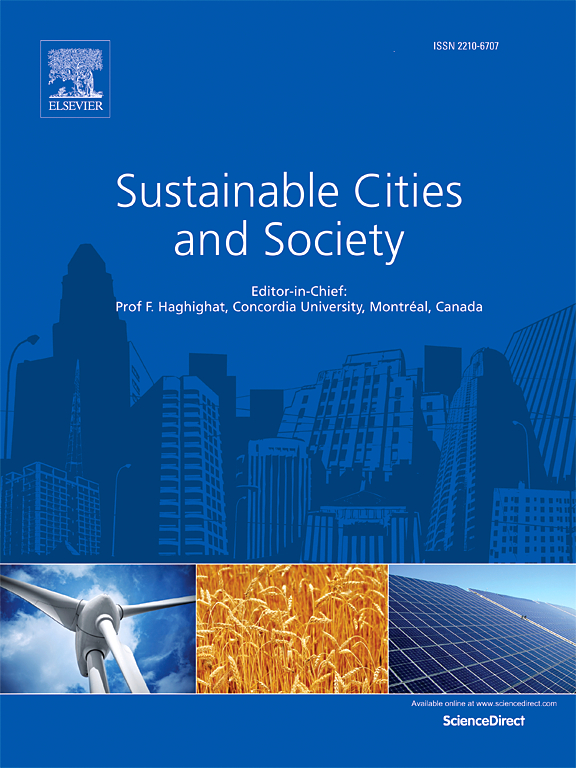Urbanization-induced disparity of extreme heat distribution in metropolitan Beijing
IF 10.5
1区 工程技术
Q1 CONSTRUCTION & BUILDING TECHNOLOGY
引用次数: 0
Abstract
Cities are facing more frequent, intense, and prolonged extreme heat (EH) due to climate change and urban heat island effects. While the urban-rural EH difference is well documented, intra-urban EH distribution and the influence of local urbanization trajectories remain largely unknown. Here, we use five EH indices derived from in-situ observations and a global seamless near surface air temperature dataset to measure the frequency, intensity and diurnal changes of EH in Beijing. We first evaluate the dataset’s reliability in capturing intra-urban EH variations, then investigate how EH correlates with urbanization trajectories based on changes in land use and population from 2000 to 2020. We employ linear regressions to quantify the spatial pattern of EH within the city and clustering algorithms to analyze the impact of urbanization on EH. We find a clear urban-rural EH gradient, with the annual values of frequency and intensity increasing by 207.8 % and 27.8 % toward the city center, while the diurnal temperature range decreases, limiting nighttime heat relief in downtown areas. This reverse pattern underscores the rising threat of compound EH throughout the day and night for urban residents. Additionally, EH disparities among groups categorized by changes in land use and population highlights disproportionate heat stress in densely populated neighborhoods. Our study offers new insights on understanding the intra-urban EH variations for heat stress mitigation and adaptation.
城市化引发的北京大都市区极端高温分布差异
由于气候变化和城市热岛效应,城市正面临更频繁、更强烈和更长时间的极端高温。虽然城乡EH差异有充分的文献记录,但城市内EH分布和当地城市化轨迹的影响在很大程度上仍然未知。本文利用5个EH指数和全球无缝近地表气温数据,测量了北京地区EH的频率、强度和日变化。我们首先评估了数据集在捕获城市内部EH变化方面的可靠性,然后研究了EH如何与2000年至2020年基于土地利用和人口变化的城市化轨迹相关。本文采用线性回归方法量化城市环境污染的空间格局,并采用聚类算法分析城市化对环境污染的影响。研究发现,EH具有明显的城乡梯度,其频率和强度的年值分别向市中心方向增加了207.8%和27.8%,而日温差减小,限制了市中心夜间的热释放。这种相反的模式强调了复合EH在白天和夜间对城市居民的威胁日益增加。此外,按土地利用和人口变化分类的群体之间的EH差异突出了人口密集社区不成比例的热应激。我们的研究为理解城市内部EH变化对热应激的缓解和适应提供了新的见解。
本文章由计算机程序翻译,如有差异,请以英文原文为准。
求助全文
约1分钟内获得全文
求助全文
来源期刊

Sustainable Cities and Society
Social Sciences-Geography, Planning and Development
CiteScore
22.00
自引率
13.70%
发文量
810
审稿时长
27 days
期刊介绍:
Sustainable Cities and Society (SCS) is an international journal that focuses on fundamental and applied research to promote environmentally sustainable and socially resilient cities. The journal welcomes cross-cutting, multi-disciplinary research in various areas, including:
1. Smart cities and resilient environments;
2. Alternative/clean energy sources, energy distribution, distributed energy generation, and energy demand reduction/management;
3. Monitoring and improving air quality in built environment and cities (e.g., healthy built environment and air quality management);
4. Energy efficient, low/zero carbon, and green buildings/communities;
5. Climate change mitigation and adaptation in urban environments;
6. Green infrastructure and BMPs;
7. Environmental Footprint accounting and management;
8. Urban agriculture and forestry;
9. ICT, smart grid and intelligent infrastructure;
10. Urban design/planning, regulations, legislation, certification, economics, and policy;
11. Social aspects, impacts and resiliency of cities;
12. Behavior monitoring, analysis and change within urban communities;
13. Health monitoring and improvement;
14. Nexus issues related to sustainable cities and societies;
15. Smart city governance;
16. Decision Support Systems for trade-off and uncertainty analysis for improved management of cities and society;
17. Big data, machine learning, and artificial intelligence applications and case studies;
18. Critical infrastructure protection, including security, privacy, forensics, and reliability issues of cyber-physical systems.
19. Water footprint reduction and urban water distribution, harvesting, treatment, reuse and management;
20. Waste reduction and recycling;
21. Wastewater collection, treatment and recycling;
22. Smart, clean and healthy transportation systems and infrastructure;
 求助内容:
求助内容: 应助结果提醒方式:
应助结果提醒方式:


